IELTS THƯ ĐẶNG- TRUNG TÂM LUYỆN THI IELTS UY TÍN, CHẤT LƯỢNG TẠI HÀ NỘI
Tham khảo các bài liên quan:
>>> Kinh nghiệm luyện thi IELTS
>>> Hướng dẫn làm bài thi IELTS
CÁCH VIẾT DẠNG MAPS IELTS WRITING TASK 1 [ PHẦN 2 ]
Trong phần thi IELTS Writing Task 1, ngoài các dạng bài hay gặp là Charts, Processes, Pie… Maps cũng xuất hiện với tần suất không hề nhỏ. Tuy nhiên, rất nhiều sĩ tử IELTS không biết phải viết như thế nào để đạt được band điểm cao với dạng bài “khó nhằn” này.
Trước đây IELTS Thư Đặng có bài viết chia sẻ: “ Cách viết Maps trong IELTS writing task 1 - Phần 1”
Tiếp bài viết IELTS Thư Đặng sẽ phân tích thật chi tiết về cách viết Maps trong IELTS writing task 1 - phần 2 chi tiết hơn, qua bài viết sau đây để giúp các bạn có một cái nhìn tổng quan về dạng Maps và áp dụng được các cấu trúc câu cũng như các ngôn ngữ mô tả đặc trưng trong dạng bài này nhé.
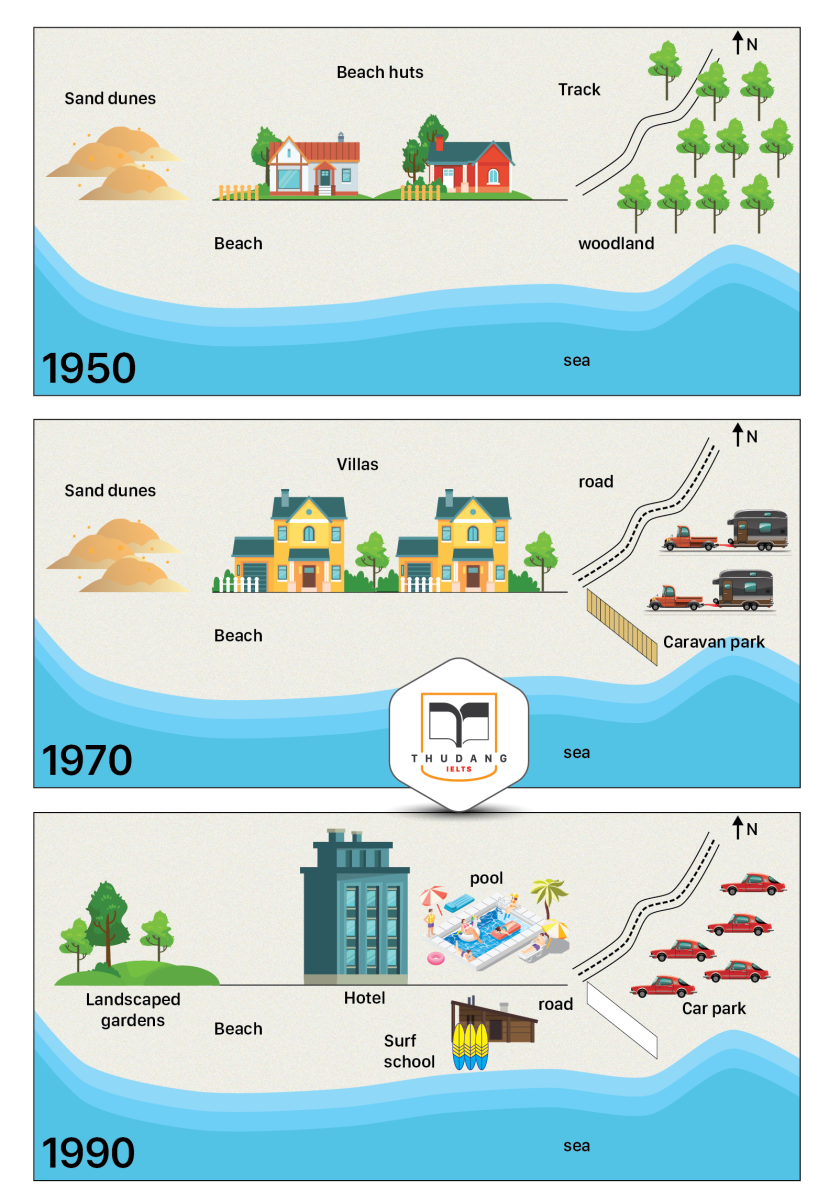
1. Maps – IELTS Writing Task 1 là gì?
Dạng Maps – IELTS Writing Task 1 là dạng đề bài yêu cầu thí sinh miêu tả các sự thay đổi, phát triển trong một khoảng thời gian nhất định của một khu vực, địa điểm như thành phố, trường học hay sân bay.
Cũng tương tự như những dạng câu hỏi khác trong Task 1, thí sinh cần dành khoảng 20 phút để viết một bài đáp ứng được 4 tiêu chí chấm thi, bao gồm: Task Achievement (trả lời đầy đủ và đúng trọng tâm câu hỏi), Coherence & Cohesion (tính liền mạch về mặt ngôn từ và ngữ nghĩa), Lexical Resource (từ vựng), Grammatical Range & Accuracy (sự đa dạng và chính xác về ngữ pháp).
2. Các dạng Maps trong IELTS Writing Task 1
Đề Maps trong IELTS Writing Task 1 thường sẽ có 2 dạng chính: 1 bản đồ và nhiều bản đồ
2.1. Dạng Maps 1 bản đồ
a. Maps không có thời gian
Loại Maps này thường sẽ chỉ cần so sánh và làm rõ các điểm khác biệt giữa 2 địa điểm trong bản đồ. Đây là dạng hiếm gặp, tuy nhiên vẫn có khả năng xuất hiện trong kỳ thi. Cùng xem ví dụ dưới đây để tham khảo nhé!
Ví dụ: The map below is of the town of Garlsdon. A new supermarket (S) is planned for the town. The map shows two possible sites for the supermarket.
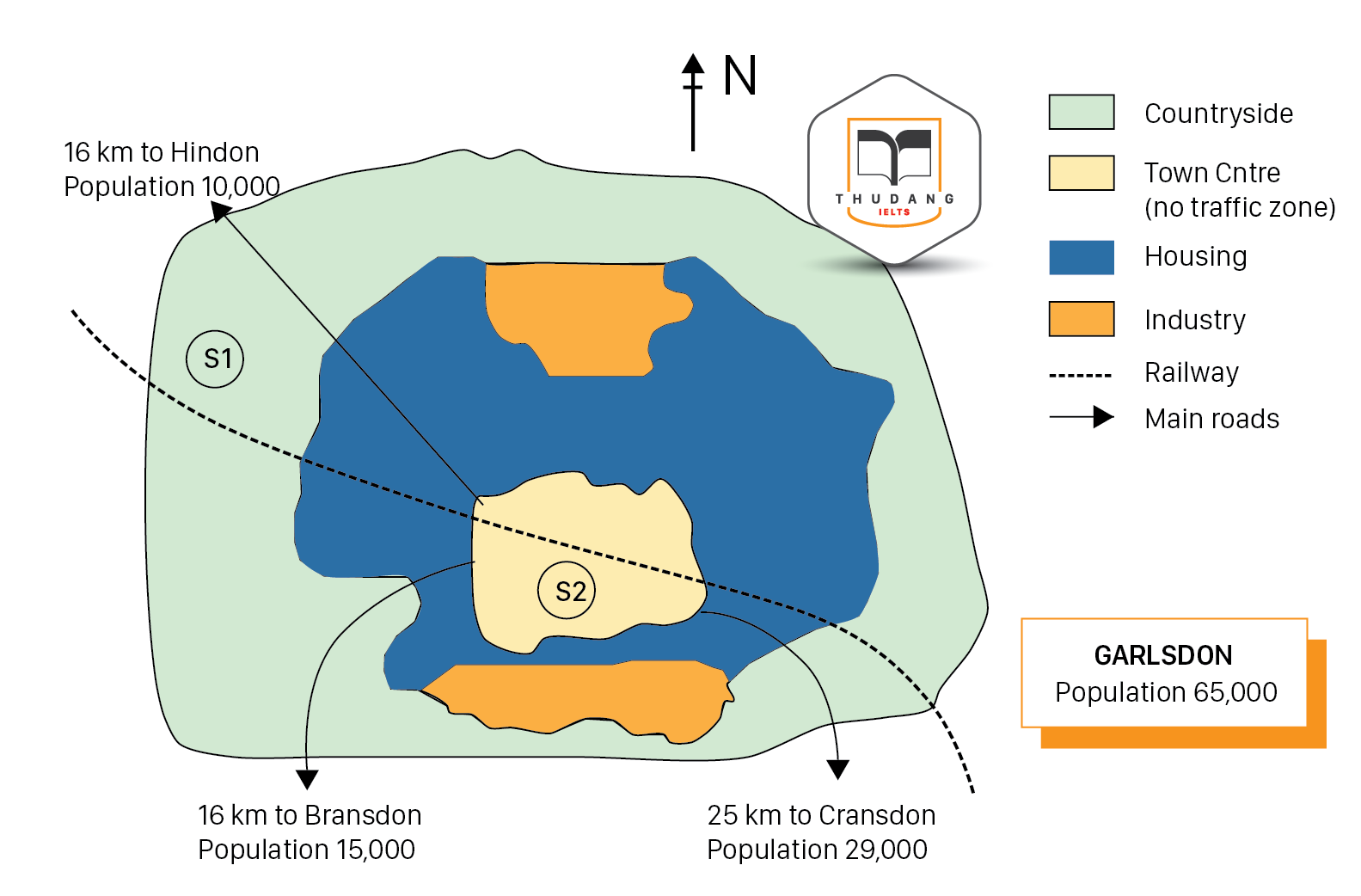
b. Có thời gian
Dạng này cũng ít khi gặp trong bài thi, tuy nhiên bạn cũng không nên chủ quan bỏ qua nhé. Ghi nhớ rằng những đề ‘độc, lạ’ thi thoảng vẫn xuất hiện làm chao đảo hàng ngàn thí sinh, đặc biệt là trong các kỳ thi IELTS trên máy tính.
Tuy chỉ có 1 bản đồ duy nhất, nhưng các sự thay đổi theo thời gian và khu vực vẫn được thể hiện bằng màu sắc hay ký hiệu, và người viết cần chỉ ra được những sự thay đổi này.
Ví dụ: Chorleywood is a village near London whose population has increased steadily since the middle of the 19th century. The map below shows the development of the village.

2.2. Loại nhiều bản đồ
Đây là dạng bài Maps phổ biến hơn, thường sẽ có 2-3 bản đồ của cùng một khu vực nhưng ở các mốc thời gian khác nhau. Người viết cần chỉ ra được các sự thay đổi và phát triển này, đồng thời dựa vào khoảng thời gian đề bài cho để sử dụng đúng các thì trong tiếng Anh.
A. 2-3 bản đồ trong quá khứ
Khi mốc thời gian nằm ở quá khứ, người viết nên sử dụng thì quá khứ hoàn thành và quá khứ đơn để mô tả bản đồ.
Ví dụ 1: The two maps below show road access to a city hospital in 2007 and in 2010.

Ví dụ đề thi IELTS Writing dạng Maps 2 bản đồ – Có mốc thời gian
Ví dụ 2: The maps below show the centre of a small town called Islip as it is now, and plans for its development.
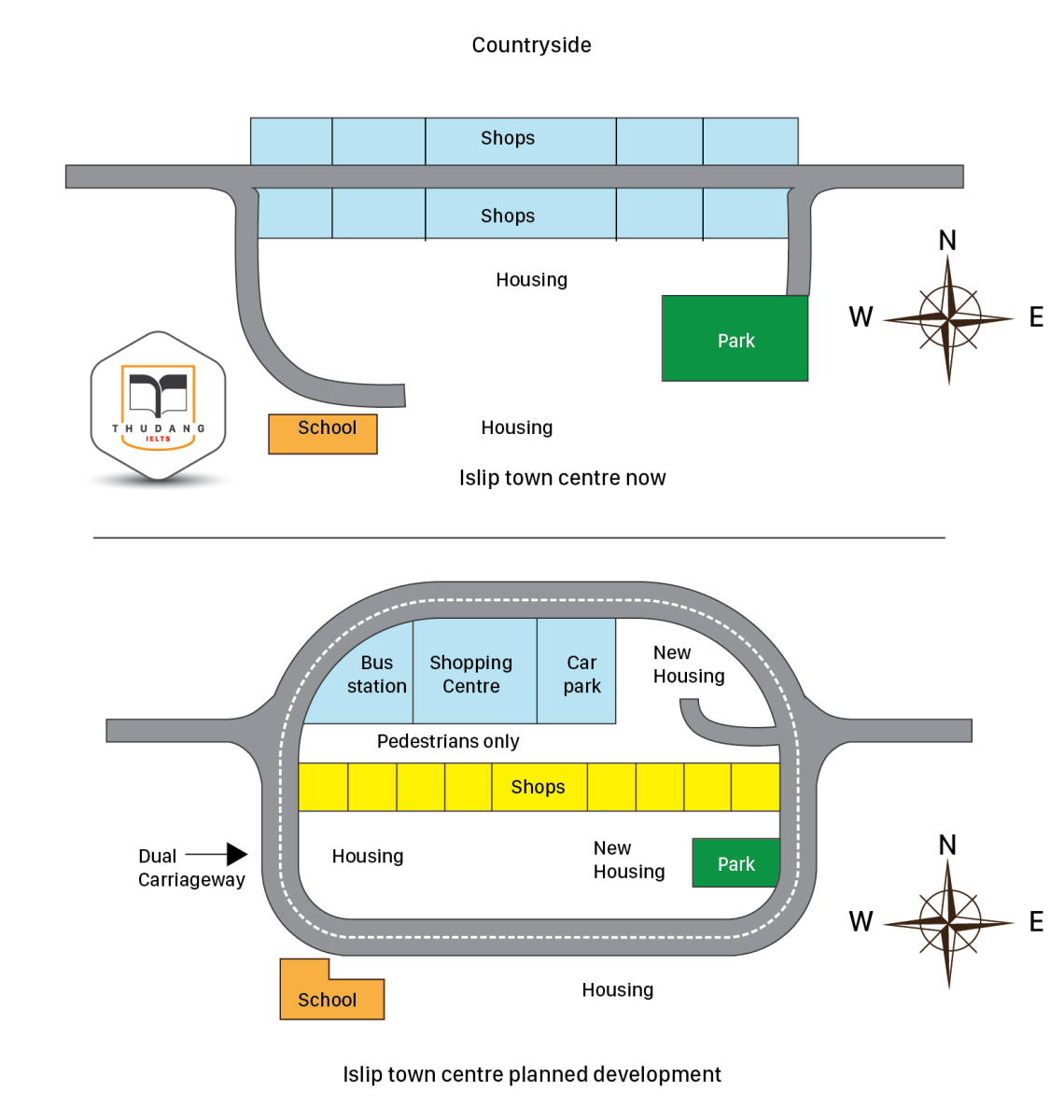
Ví dụ đề thi IELTS Writing dạng Maps 2 bản đồ – Không mốc thời gian
B. 1 bản đồ trong quá khứ và 1 bản đồ ở hiện tại
Thí sinh cần sử dụng thì quá khứ đơn và hiện tại hoàn thành để mô tả các thay đổi từ quá khứ cho tới thời điểm hiện tại.
Ví dụ: The plans below show a public park when it first opened in 1920 and the same park today.
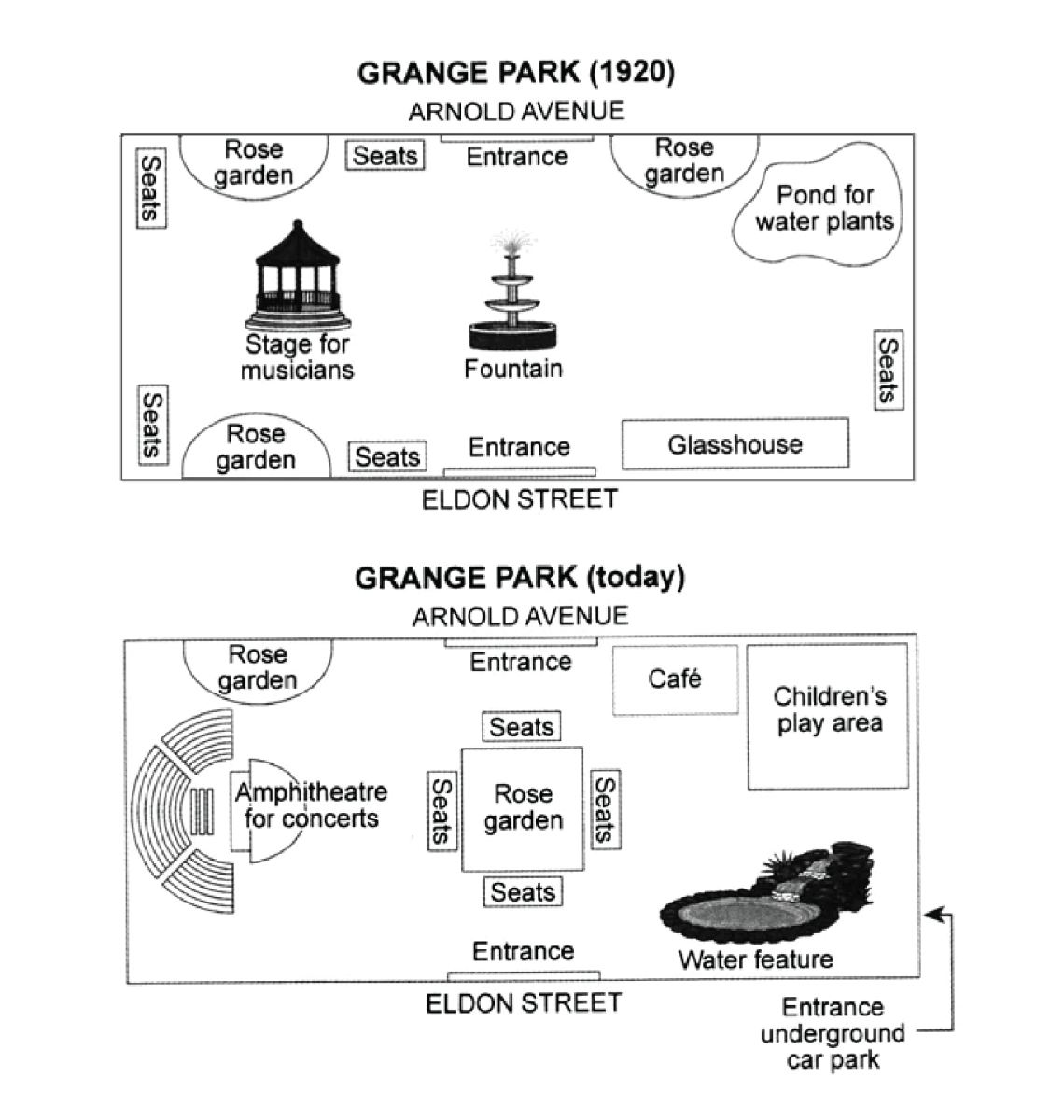
Maps - IELTS Writing Task 1 dạng 1 bản đồ trong quá khứ và 1 bản đồ ở hiện tại
C. 1 bản đồ ở hiện tại và 1 bản đồ ở tương lai
Dạng Maps này thường là một đề xuất thay đổi, phát triển của một khu vực trong tương lai. Người viết cần sử dụng nhuần nhuyễn thì hiện tại đơn và các thì về tương lai để tối ưu hóa điểm ngữ pháp.
3. Cấu trúc dạng bài Maps
Tương tự như các dạng bài biểu đồ hay quy trình sản xuất, một bài viết về Maps sẽ có bố cục 3 phần:
3.1. Introduction
Ở phần mở bài, chúng ta cần paraphrase câu hỏi bằng cách sử dụng từ đồng nghĩa hoặc thay đổi cấu trúc câu.
IELTS Thư Đặng sẽ cung cấp cho bạn 2 công thức viết Introduction đơn giản, dễ nhớ và dễ áp dụng như sau:
- The maps show/illustrate/demonstrate how [tên khu vực] change(d) over a [số năm]-year period from……..to……..
Example: The maps illustrate how Spanish city of Castellon change(d) over a 10-year period from 2000 to 2010.
- The maps show/illustrate/demonstrate the changes of [tên khu vực] over a [số năm]-year period between___ and___.
Example: The maps demonstrate the changes of Spanish city of Castellon over a 10-year period from 2000 to 2010.
3.2. Overview
Câu tổng quan luôn là phần quan trọng nhất của một bài Task 1, chính vì vậy người viết cần khái quát được sự thay đổi, phát triển của khu vực trong bản đồ và lưu ý không tập trung quá vào chi tiết.
Cấu trúc chung của Overview:
Generally, it is clear that the [khu vực] [see/witness/experience] [major changes/ striking transformations/ a significant modernization/ remarkable developments/]. Most noticeably, + một thay đổi nổi bật nhất từ bản đồ.
Example: Generally, it is clear that the village of Ryemouth witnesses a significant modernization. Most noticeably, the increases in accommodation, the elimination of the fishing industry, and the introduction of sports facilities
3.3. Body
Hai đoạn thân bài sẽ tập trung vào mô tả chi tiết. Tùy vào từng đề bài, người viết có thể nhóm thông tin theo thời gian hoặc khu vực (Bắc-Nam hoặc Đông-Tây) để làm rõ và so sánh sự khác biệt giữa hai bản đồ. Để xác định phương hướng trong tiếng Anh, mời bạn tham khảo phần tiếp theo nhé!
4. Ngôn ngữ dùng trong Maps
4.1. Câu bị động (passive voice)
Vì sự phát của bất kỳ một khu vực nào là do con người thực hiện, chúng ta nên sử dụng câu bị động kết hợp với thì phù hợp để mô tả sự thay đổi.
Ví dụ:
A new tram line has been built.
A bike-rental scheme had been introduced.
Tuy nhiên, cần lưu ý các từ/ cụm từ ‘take place’, become’, ‘change’ và ‘make way for’ không được chia bị động.
Ví dụ:
A number of important changes have taken place in the last decade.
The city became much more modern.
The cinema was knocked down to make way for a new shopping centre.
Hãy cùng thử thực hành một bài tập nhỏ về chia động từ của IELTS Thư Đặng các bạn lưu ý sử dụng thì hiện tại hoàn thành nhé:
- The city used to be very green, but it ………… much more industrial. (become)
- A new sports centre in the ……….. city centre. (construct)
- The own stadium …………… and replaced by a new one. (demolish)
- Many significant changes …………. in the city in the last ten years. (take place)
- The old town hall …………. and replaced by new flats. (knock down)
- In the last 15 years, the city ………….. considerably, from a quiet market town into a much busier small city. (change)
4.2. Ngôn ngữ chỉ phương hướng (Language of Directions)
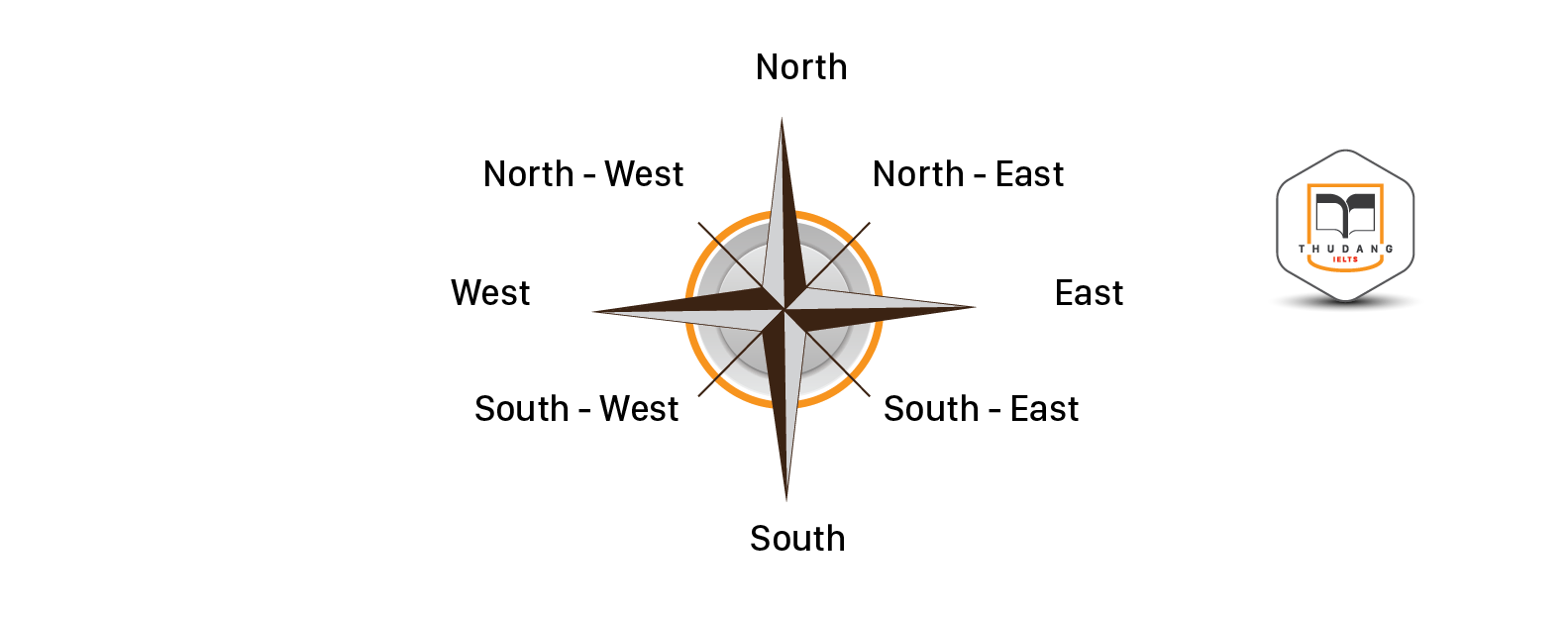
Người viết cần xác định được 4 hướng chính và 4 hướng phụ để mô tả chính xác các khu vực trong bản đồ. Một mẹo nhỏ là chỉ cần vẽ một chiếc la bàn như hình trên bên cạnh bản đồ nếu đề bài không cho sẵn, điều này sẽ giúp thí sinh tránh được sai sót khi làm bài.
- Lưu ý giới từ ‘to’ và ‘in’ khi miêu tả vị trí
‘to’: khi 2 địa điểm nằm cạnh nhau nhưng tách biệt
‘in’: khi 1 địa điểm nằm trong 1 khu vực hoặc 1 ngôi làng/thành phố
.png)
- Corner
Khi các địa điểm nằm ở các góc của một khu vực, cần viết hướng dưới dạng tính từ bằng cách thêm ‘-ern’ khi kết hợp với danh từ ‘corner’.

* 4 corners: South-Eastern corner/ South-Western corner/ North-Eastern corner/ North-Western corner
- Location of a building or site
Để miêu tả vị trí của một địa điểm, bạn có thể sử dụng một trong ba cách sau:
– There + to be + noun 1 + position phrase + noun 2 – Noun 1 + to be + located/ sited/ situated + position phrase + noun 2 – Noun 1 + stand/ lie/ flow + position phrase + noun 2 |
Ví dụ:
- There was a bank to the North of the town hall in 2000.
- A school was located to the South of the supermarket in 1990.
- A park stood in the North-Eastern corner of the village.
4.3. Ngôn ngữ miêu tả sự thay đổi (Language of changes)
Khía cạnh quan trọng nhất của bản đồ là sự thay đổi theo thời gian của một khu vực được cho sẵn, nhiệm vụ của người viết là nêu ra được các sự thay đổi này bằng cách sử dụng từ vựng đa dạng và linh hoạt.
IELTS Thư Đặng giúp bạn ghi nhớ các từ vựng dễ dàng hơn bằng cách phân loại thành 8 categories theo bảng sau:
A. New additions & removal
New additions | Meaning |
build | xây dựng |
construct | xây dựng |
erect | xây dựng |
Introduce | đưa vào sử dụng |
set up | thành lập |
open | mở cửa |
occupy | chiếm chỗ |
add | thêm vào |
Removal | Meaning |
cut down (trees) | chặt cây |
chop down (trees) | chặt cây |
clear (trees) | chặt cây |
Demolish | phá huỷ |
remove | loại bỏ |
no longer there | không còn nữa |
pull down | phá huỷ |
Flatten | san bằng |
knock down | phá bỏ |
B. Replacements & Relocation
Replacements | Meaning |
convert into | chuyển thành |
make into | làm thành |
turn into | chuyển thành |
redevelop into | phát triển lại thành |
replace | thay thế |
Relocation | Meaning |
Move | di chuyển |
relocate | di dời |
C. Make bigger and smaller
Make bigger | Meaning |
enlarge | mở rộng |
expand | mở rộng |
Extend | kéo dài |
widen | mở rộng |
Make smaller | Meaning |
shrink | co lại |
reduce in size | giảm kích thước |
D. No change
No change | Meaning |
remain unchanged | không thay đổi |
stay the same | giữ nguyên |
no change | không có sự thay đổi |
E. General statements about changes
General statements about changes | Meaning |
industrialize | công nghiệp hoá |
modernize | hiện đại hoá |
transform | biến đổi |
urbanize | đô thị hoá |
pedestrianize | chuyển thành khu đi bộ |
Ngoài ra, thay vì chỉ sử dụng động từ như ‘demolish’ (vd: The old market has been demolished), bạn có thể sử dụng một cụm danh từ để đa dạng diễn đạt.
Ví dụ:
- One notable development has been the demolition of the old market.
- Another change was the construction of a new football stadium.
Một số danh từ của các động từ thường sử dụng trong Maps
Verb | Noun | Meaning |
demolish | demolition | sự phá huỷ |
construct | construction | sự xây dựng |
build | building | sự xây dựng |
open | opening | sự mở cửa |
knock down | knocking down | sự phá bỏ |
expand | expansion | sự mở rộng |
convert | conversion | sự chuyển đổi |
introduce | introduction | sự đưa vào sử dụng |
replace | replacement | sự thay thế |
extend | extension | sự kéo dài |
Verb | Noun | Meaning |
cut down | cutting down | sự chặt bỏ |
transform | transformation | sự biến đổi |
industrialize | industrialization | sự công nghiệp hoá |
erect | erection | sự xây dựng |
modernize | modernization | sự hiện đại hoá |
urbanize | urbanization | sự đô thị hoá |
redevelop | redevelopment | sự phát triển lại |
pedestrianize | pedestrianization | sự chuyển thành khu đi bộ |
enlarge | enlargement | sự mở rộng |
disappear | disappearance | sự biến mất |
Bài tập áp dụng
- It is noteworthy that there has been a ………….. of the port area. (redevelop)
- Another striking change is the ……………… of the university (expand)
- A notable change has been the …………….. of the old train station into a police station. (convert)
- The whole city has experienced a significant ……………… in the last ten years. (modernize)
- A remarkable development has been the ……………. of a bike-rental scheme. (introduce)
- There did not use to be a cinema or shops near the port, but the last few years have seen the …………. of new facilities in the port area. (build)
5. Các lỗi sai thường gặp đối với dạng Maps
Các lỗi sai kinh điển mà thí sinh thường mắc phải khi mô tả Maps sẽ được IELTS Thư Đặng phân tích kỹ trong bài viết này, nhằm giúp người đọc tránh được các sai sót tương tự khi làm bài.
5.1. Lỗi về mạo từ
Một trong những lỗi sai mà sĩ tử IELTS thường hay gặp nhất đó chính là dùng sai mạo từ ‘a’ và ‘the’ khi kết hợp với các danh từ chỉ địa điểm.
Ví dụ: The maps below show changes that took place in Felixstone from 1967 to 2001.
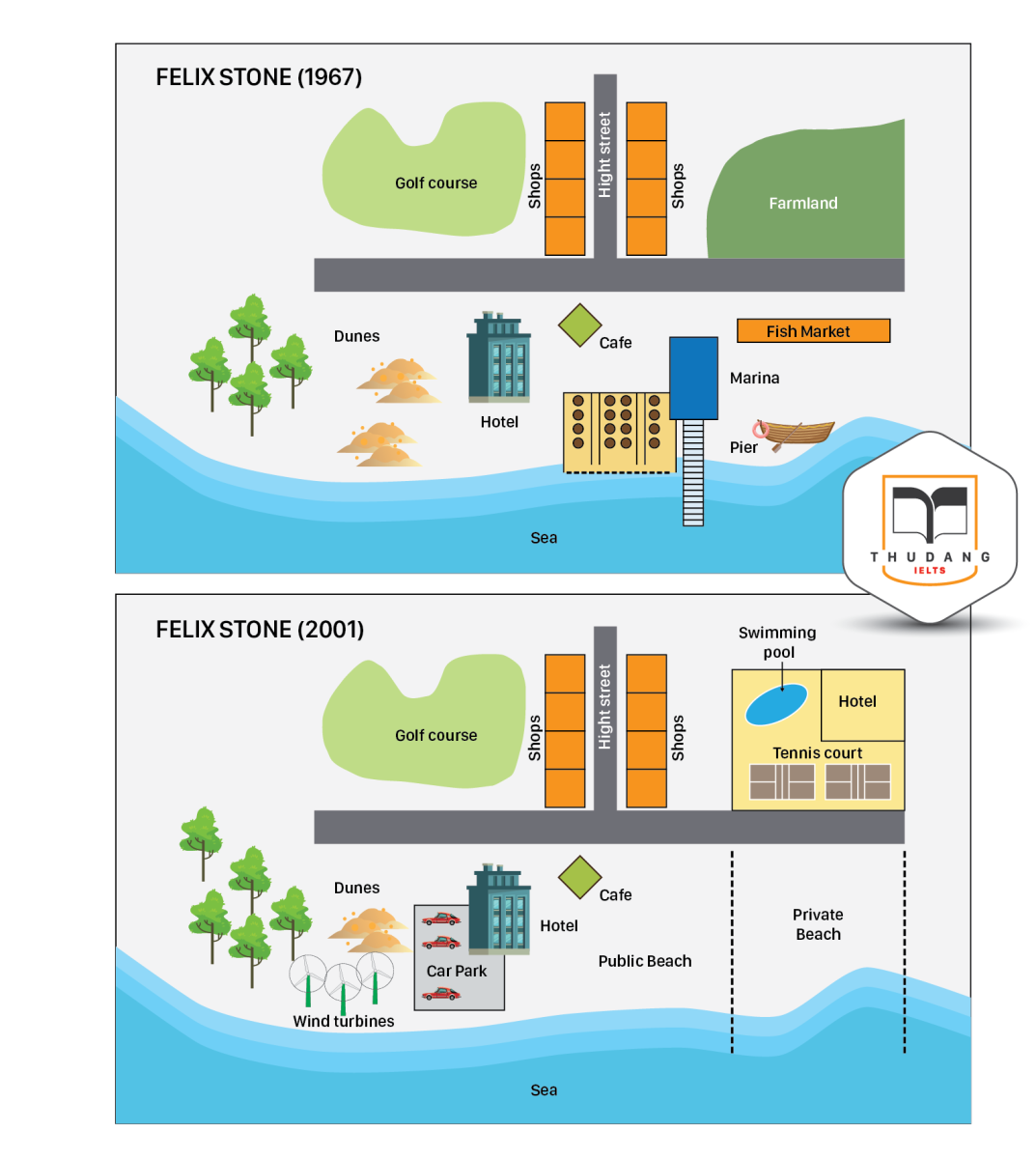
- While a golf course in the northwest remained unchanged, more shops were added to a row of shops along the eastern side of High street. (SAI)
→ While the golf course in the northwest remained unchanged, more shops were added to the row of shops along the eastern side of High street. (ĐÚNG)
- A farmland in the northeastern corner was turned into the large entertainment complex with the swimming pool, the hotel and tennis courts. (SAI)
→ The farmland in the northeastern corner was turned into a large entertainment complex with a swimming pool, a hotel and tennis courts. (ĐÚNG)
Ở hai ví dụ trên, người viết đang nhầm lẫn giữa 2 mạo từ ‘the’ và ‘a’. Cần lưu ý đối với những địa điểm đã có ở bản đồ đầu tiên, cần dùng mạo từ xác định ‘the’, còn những địa điểm xuất hiện muộn hơn ở biểu đồ thứ hai sẽ đi với ‘a’ nếu là danh từ số ít, hoặc không cần mạo từ mà chỉ thêm ‘s/es’ nếu là danh từ số nhiều.
5.2. Lỗi về thì
Người viết cần chú ý mốc thời gian được cho ở đề bài để sử dụng các thì trong tiếng Anh một cách chính xác.
Xét ví dụ ở trên:
- The cafe in the centre of the beach is still in the same place, while a new car park is built next to the hotel. (SAI)
→ The cafe in the centre of the beach was still in the same place, while a new car park was built next to the hotel. (ĐÚNG)
Rõ ràng 2 thời điểm được cho trong đề bài đều ở quá khứ (1967 và 2001), do đó thí sinh cần sử dụng thì quá khứ đơn hoặc quá khứ hoàn thành để mô tả các sự thay đổi trong bản đồ.
Ví dụ 2: The plans below show a public park when it first opened in 1920 and the same park today.
- It is clear that the park experienced striking transformations since its opening in 1920. (SAI)
→ It is clear that the park has experienced striking transformations since its opening in 1920. (ĐÚNG)
Tương tự, vì câu hỏi đề cập đến sự phát triển của công viên cho tới thời điểm hiện tại, người viết nên sử dụng thì hiện tại hoàn thành trong bài viết của mình.
5.3. Lỗi các động từ ở thể bị động và chủ động
Tuy đa phần các diễn đạt của bài Maps được viết ở câu bị động, vẫn có một số các động từ chỉ được dùng ở dạng chủ động. Thí sinh cần lưu ý để tránh nhầm lẫn khi luyện tập cũng như khi làm bài thi.
Ví dụ 1:
- A large number of buildings were built. (ĐÚNG)
- A large number of buildings were mushroomed. (SAI)
→ A large number of buildings mushroomed. (ĐÚNG)
- ‘mushroom’ là nội động từ, có nghĩa ‘tăng nhanh’, do đó chỉ được dùng trong câu chủ động.
Ví dụ 2:
- A significant development was taken place in the village. (SAI)
- A significant development took place in the village. (ĐÚNG)
- ‘take place’ cũng là nội động từ, mang nghĩa ‘xảy ra’ và cần viết dưới dạng chủ động.
5.4. Lỗi về giới từ
- to make way for và to give way to
Cả 2 cụm từ trên đều có nghĩa là ‘nhường chỗ cho cái khác’. Tuy nhiên, thí sinh cần lưu ý dùng đúng giới từ ‘for’ và ‘in’ cho mỗi cụm từ.
- in the corner và at the corner
– ‘in the corner’ được sử dụng để miêu tả vị trí của một địa điểm trong một tòa nhà, một ngôi làng, một thành phố hay khu vực nào đó.
Ví dụ:
The school in the southeastern corner of the village had been demolished to give way to a theatre.
The ATM in the northwestern corner of the hall was relocated to the centre.
– ‘at the corner’ dùng để chỉ góc giao nhau của 2 con đường
Ví dụ: There used to be a cafe at the corner of West Street and Park Street.
6. Phân tích bài mẫu
Chỉ đọc lý thuyết suông thì chắc chắn bạn sẽ không thể nào ghi nhớ hết các kiến thức quan trọng của dạng bài Maps, vì vậy hãy cùng tham khảo một số sample answers được biên soạn bởi đội ngũ học thuật tại IELTS Thư Đặng để thực hành cách viết dạng maps trong IELTS writing task 1 tốt hơn nhé.
Sample 1
The map below is of the town of Garlsdon. A new supermarket (S) is planned for the town. The map shows two possible sites for the supermarket. |
.png)
1. Dàn bài
- Introduction: Giới thiệu về 2 địa điểm dự kiến của một siêu thị của Garlsdon.
- Body 1: Mô tả về vị trí S1 và chỉ ra các điểm thuận tiện về giao thông cho dân cư của các thị trấn.
- Body 2: Mô tả về vị trí S2, cũng như chỉ ra các ưu điểm và bất lợi về giao thông cho dân cư của các thị trấn.
- Overview: Đưa ra nhận xét khách quan về địa điểm nào có ưu thế hơn.
2. Sample Answer
The map shows two proposed locations for a new supermarket for the town of Garlsdon.
The first potential location (S1) is outside the town itself, and is sited just off the main road to the town of Hindon, lying 12 km to the north-west. This site is in the countryside and so would be able to accommodate a lot of car parking. This would make it accessible to shoppers from both Hindon and Garlsdon who could travel by car. As it is also close to the railway line linking the two towns to Cransdon (25 km to the south-east), a potentially large number of shoppers would also be able to travel by train.
In contrast, the suggested location S2 is right in the town centre, which would be good for local residents. Theoretically, the store could be accessed by road or rail from the surrounding towns, including Bransdon, but as the central area is a no-traffic zone, cars would be unable to park and access would be difficult.
Overall, neither site is appropriate for all the towns, but for customers in Cranston, Hindon, and Garlsdon, the out-of-town site (S1) would probably offer more advantages.
3. Các từ vựng cần highlight
- off (prep) = near to: gần
- accommodate (v): cung cấp chỗ, không gian
- accessible (adj): có thể tiếp cận
- theoretically (adv): trên lý thuyết
- no-traffic zone (noun phrase): vùng không có giao thông
- appropriate (adj): phù hợp
- out-of-town (adj): ở ngoài thị trấn
Sample 2
The two maps below show road access to a city hospital in 2007 and in 2010. |
.png)
1. Dàn bài
- Introduction: Giới thiệu về địa điểm và thời gian diễn ra sự thay đổi.
- Overview: Chỉ ra đặc điểm tổng quát: cơ sở hạ tầng giao thông đã được nâng cấp để cả phương tiện giao thông cá nhân và công cộng dễ dàng tiếp cận bệnh viện hơn.
- Body 1: Mô tả mạng lưới đường đi xung quanh bệnh viện không thay đổi.
- Body 2: Mô tả các sự thay đổi về bãi đậu xe và trạm xe buýt, đặc biệt là sự xuất hiện của 2 bùng binh tại các giao lộ.
2. Sample Answer
The maps illustrate the changes of road access to a particular city hospital between 2007 and 2010.
Overall, it is clear that transport facilities in the area had been renovated to provide easy access to the hospital by both private and public vehicles.
The road network remained unchanged over the period in question, with two access roads to the hospital, one built around the hospital building itself (Ring Road), and the other located to the south named Hospital Road.
In 2007, a car park for both the staff and the public was sited at the corner of City Road and Hospital Road, to the south-east of the hospital. By 2010, it had become accessible for the staff only, while a new public car park was constructed to the eastern side, adjacent to Ring Road. Another striking change was the erection of two roundabouts at the intersections of Hospital Road with Ring Road and City Road to improve the traffic flow there. A final transformation was the conversion of six bus stops along either side of Hospital Road into a large bus stop situated to the south-west of the hospital, with two exits to the two roundabouts.
3. Các từ vựng cần highlight
- easy access (noun phrase): sự đi lại dễ dàng
- adjacent to (prep): kế bên
- roundabout (n): bùng binh
- traffic flow (n): luồng giao thông
- exit (n): lối ra
Sample 3
Chorleywood is a village near London whose population has increased steadily since the middle of the 19th century. The map below shows the development of the village. |
.png)
1. Dàn bài
- Introduction: Giới thiệu về địa điểm và thời gian diễn ra sự thay đổi.
- Overview: Chỉ ra mối liên hệ trực tiếp giữa 4 giai đoạn phát triển của ngôi làng với sự phát triển của cơ sở hạ tầng giao thông.
- Body 1: Sự thay đổi, phát triển của Chorleywood ở 2 giai đoạn đầu (1868-1883), đặc biệt là sự xuất hiện của railway.
- Body 2: Sự thay đổi, phát triển của Chorleywood ở 2 giai đoạn cuối (1922-1994), nổi bật là sự xuất hiện của motorway.
2. Sample Answer
The map illustrates how the village of Chorleywood had developed from 1868 to 1994.
Overall, it is clear that there were four periods of growth throughout these years, all directly linked to the improvement of transport infrastructure since each populated area was either near the main roads, the railway, or the motorway.
Chorleywood merely occupied a small area adjacent to the main road in the west of the map between 1868 and 1883, but later expanded along this road to the south until 1992. A remarkable change was the construction of a railway in 1909, acrossing the area from west to east, with the Chorleywood station being sited roughly in the middle of this new part of village.
From 1922 to 1970, Chorleywood continued to grow eastwards and westwards alongside the new railway. It was not until 1970 that a motorway was built in the east, and population had mushroomed around the intersections of the motorway with the railway and one of the main roads during the period of 1970-1994. Meanwhile, the Chorleywood park and golf course were located right in the centre of the map, next to the main road in the north and close to many parts of the village.
3. Các từ vựng cần highlight
- be directly linked to (phrase): liên quan trực tiếp tới cái gì
- populated area (noun phrase): vùng dân cư sinh sống
- eastwards (adv): về phía đông
- westwards (adv): về phía tây
- alongside (adv/ prep): dọc theo
- mushroom (v): tăng nhanh, nhiều
- intersection (n): ngã tư, giao lộ
Sample 4
The maps below show the changes in the art gallery ground floor in 2005 and the present day. Summarize the information by selecting the main features, and make comparisons. |
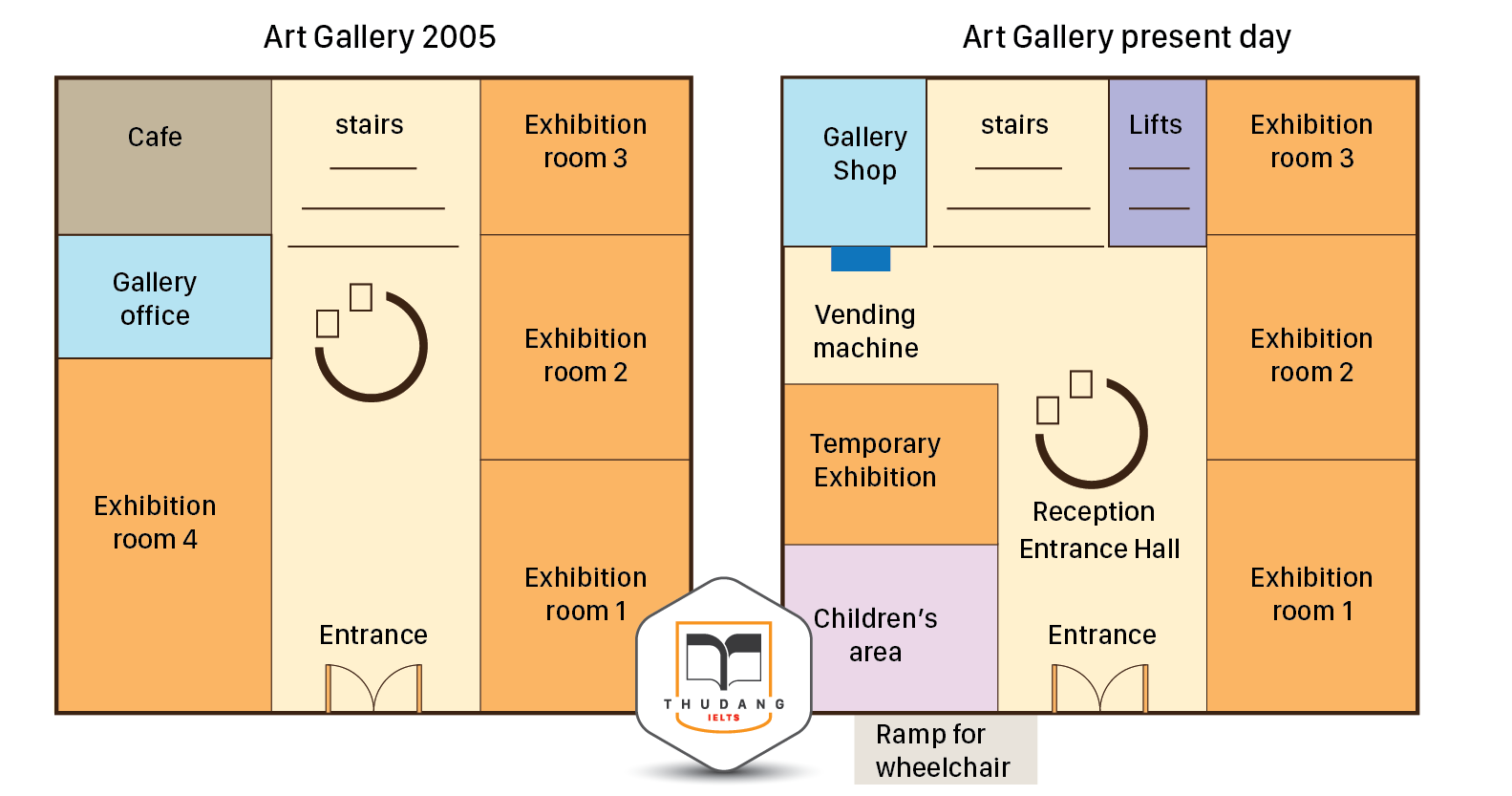
1. Dàn bài
- Introduction: Giới thiệu về địa điểm và thời gian diễn ra sự thay đổi.
- Overview: Làm nổi bật khu vực nào không thay đổi và khu vực nào thay đổi đáng kể cũng như đưa ra sự thay đổi mang tính điển hình nhất – khu triển lãm nghệ thuật có thêm lối đi hỗ trợ cho người khuyết tật.
- Body 1: Thiết kế năm 2005 – Triển lãm được thiết kế cho mục đích chính là trưng bày tác phẩm.
- Body 2: Thiết kế hiện tại – Triển lãm được trang bị thêm các trang thiết bị và dịch vụ, đặc biệt là lối đi riêng và thang máy hỗ trợ người khuyết tật.
2. Sample Answer band 8.0+
The maps reveal some changes taking place to the layout of an art gallery’s ground floor between 2005 and the present day.
In general, while the eastern part of the gallery has remained more or less intact over time, the opposite side has undergone significant transformations, with the whole area becoming more accessible for the disabled.
Originally, the gallery was designed merely for its exhibition purpose and visitors could enter the hall through the entrance in the south of the building. Inside the hall, there was a reception desk to welcome visitors, which led to a staircase in the north end. The remaining part simply consisted of functional areas with a set of 3 exhibition rooms on the eastern wing, one large exhibition space together with an office taking up the entire southwestern corner, and a café in the northwest.
At present, the location has become modernized and versatile, providing more facilities for visitors, especially with the addition of a wheelchair slope right outside the entrance to the west and a lift next to the stairs. To the west, exhibition room 4 was converted into a children’s indoor playground and one smaller room for temporary display, while a gallery shop and a vending machine were opened in place of the original gallery office and the cafe. The final alteration that happened was the relocation of the reception towards the entrance of the gallery.
3. Các từ vựng cần highlight
- Layout (N – C1): bố cục
- Intact (Adj – C1): nguyên vẹn
- Transformation (N – C1): sự biến đổi hoàn toàn
- Accessible (Adj – C1): có thể tiếp cận
- Merely (Adv – C1): chỉ duy nhất (giống only)
- The eastern wing (N – B1): chỉ khu vực cánh phía đông của một tòa nhà
- Entire (Adj – B2): hoàn toàn
- Versatile (Adj – C2): đa năng, linh hoạt
- Convert into (V – B2): chuyển đổi thành
- In place of (Phrase – B2): thay cho cái gì
- Alteration (N – C1): sự thay đổi
Sample 5
The plans below show the site of an airport now and how it will look after redevelopment last year. Summarize the information by selecting the main features, and make comparisons where relevant. |
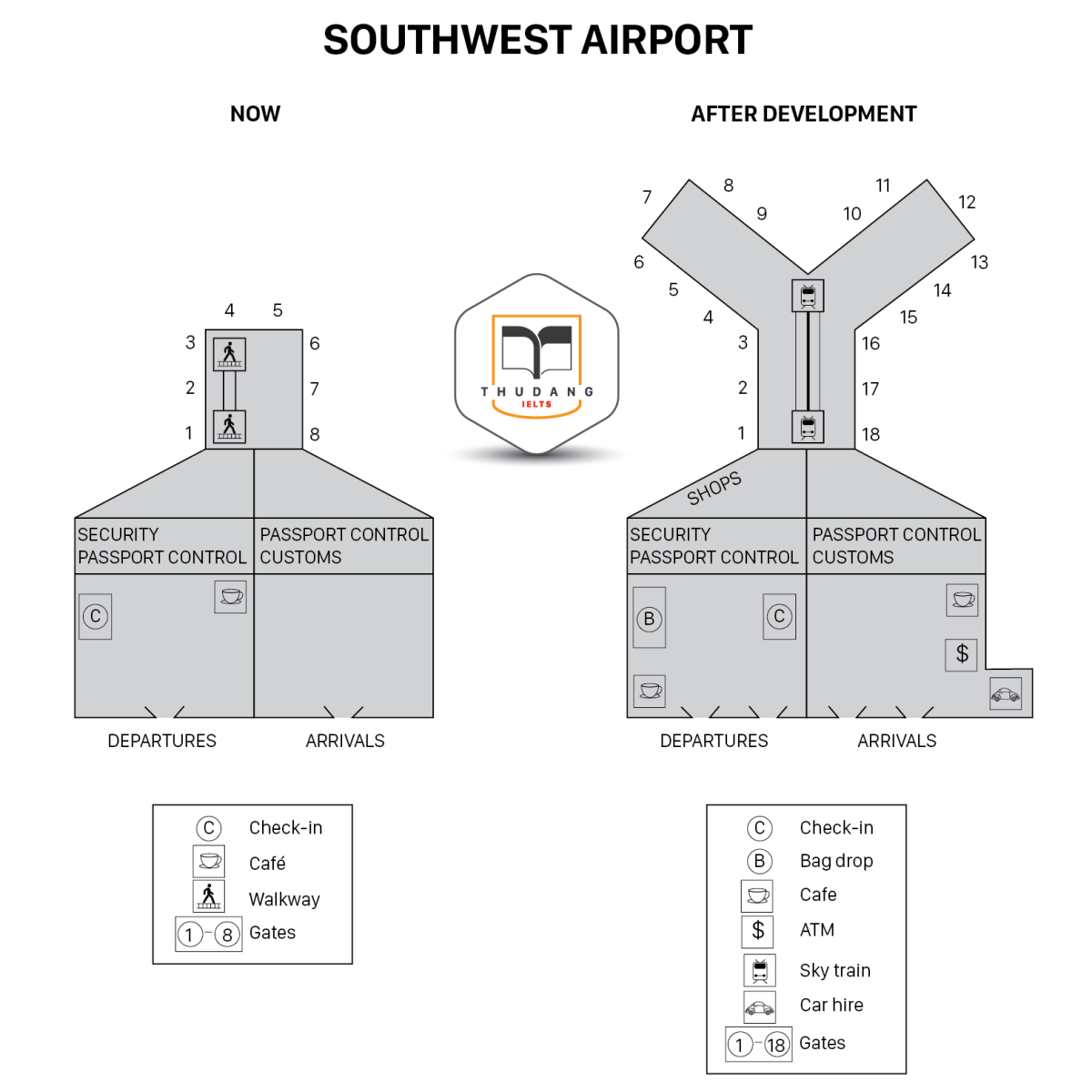
1. Dàn bài
- Introduction: Giới thiệu về địa điểm và thời gian diễn ra sự thay đổi.
- Overview: Chỉ ra sự thay đổi đáng kể của sân bay, nổi bật là sự xuất hiện của nhiều cơ sở vật chất mới và gần gấp đôi số cửa lên máy bay.
- Body 1: Mô tả các sự phát triển bên trong hai tòa nhà và các khu vực không thay đổi như passport control và security.
- Body 2: Mô tả sự thay đổi mạnh mẽ của khu vực bay, đặc biệt là sự cải tiến từ đường đi bộ thành các tàu di chuyển hành khách.
2. Sample Answer
The plans illustrate the proposed changes to the SouthWest Airport next year.
Overall, it is clear that the airport will be experiencing striking transformations, with more facilities in the buildings and roughly twice as many boarding gates.
At present, there are two terminals at the airport, one for departures and the other for arrivals, each with only one entrance in the South. The future plan proposes that there will be a new entrance added next to each existing one. Inside the departure concourse, the cafe in the Northeastern corner will have been relocated to the Southwestern corner. The check-in desk in the Western side will also be moved to the opposite wall, making way for a bag-drop section. There is not any facility in the arrivals concourse now, but a cafe, an ATM and a car-hire service are expected to be set up along the Eartern side. While the passport control and security checkpoint in the departure terminal will remain unchanged, new shops are likely to be opened in the departure lounge next year.
Currently, there are eight boarding gates which can be accessed through walkways, but it is planned that these will have been transformed into eighteen ones, standing in a fan-shaped area. A final development will be the replacement of the two walkways by sky trains, providing more convenience for passengers.
3. Các từ vựng cần highlight
- boarding gate (n): cổng lên máy bay
- terminal (n): nhà đón khách (ở sân bay)
- arrival (n): sự đến
- existing (adj): đang có sẵn
- concourse (n): khu đại sảnh
- bag-drop section (n): nơi để giỏ đồ
- passport control (n): khu vực kiểm soát hộ chiếu
- security checkpoint (n): khu vực kiểm tra an ninh
- lounge (n): buồng đợi, phòng khách
- walkway (n): lối đi dành cho người đi bộ
- sky train (n): tàu vận chuyển hành khách đến các cổng lên máy bay
- passenger (n): hành khách
Sample 6
The maps below show changes in the Spanish city of Castellon in recent times. Summarize the information by selecting the main features, and make comparisons where relevant. |
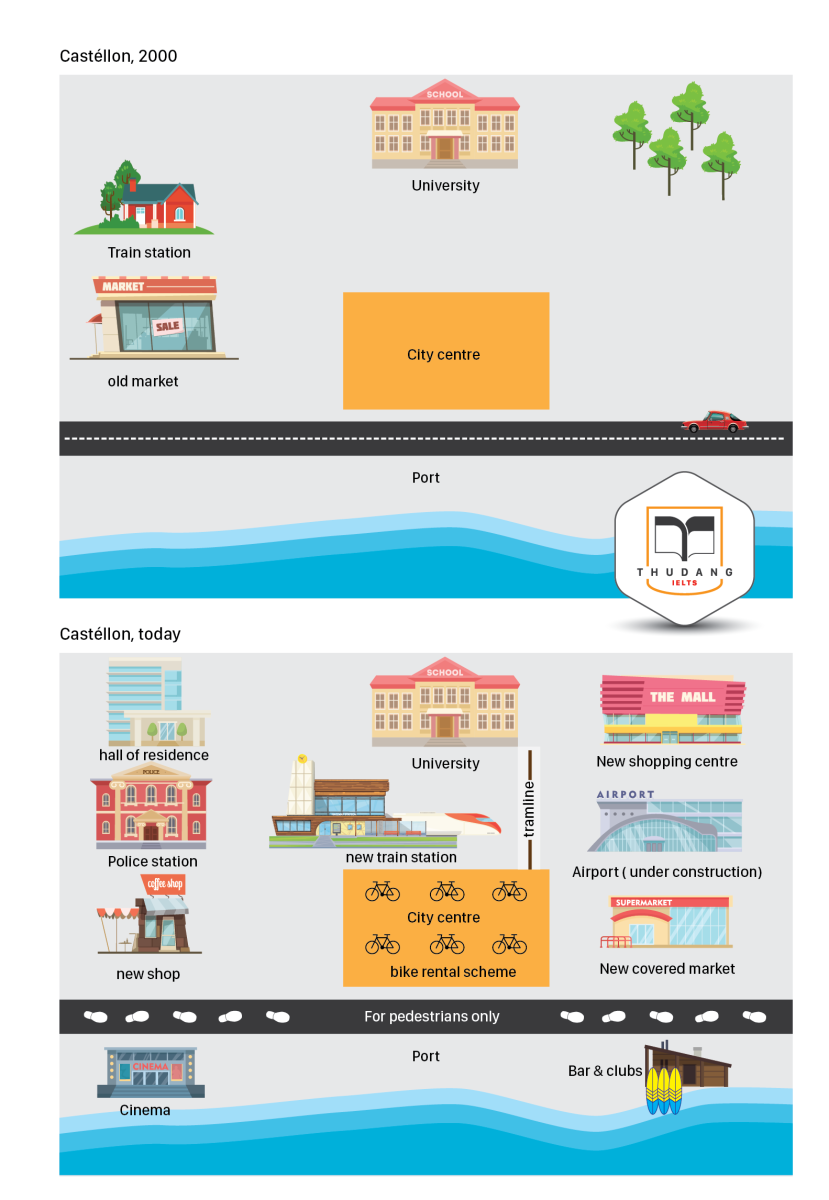
1. Dàn bài
- Introduction: Giới thiệu về địa điểm và thời gian diễn ra sự thay đổi.
- Overview: Chỉ ra điểm nổi bật: thành phố trở nên hiện đại hơn, có nhiều địa điểm mua sắm và cơ sở hạ tầng giao thông hơn.
- Body 1: Mô tả các sự phát triển ở phía bắc của thành phố, với sự xuất hiện dày đặc của các công trình xây dựng.
- Body 2: Mô tả sự thay đổi ở phía nam của thành phố, đặc biệt là các địa điểm giải trí cạnh bờ biển.
2. Sample Answer
The two maps show the main changes which have taken place in the town of Castellion between the year 2000 and today.
In general, it appears that Castellion has undergone a major modernization, with heavy investment in shopping and transport facilities.
The North of the city has become more built-up, experiencing substantial reduction in open space. One remarkable change is that a new tram line has been built to connect the university with the town centre. Meanwhile, the train station has been relocated eastwards, making way for a police station. In 2000, there was not any accommodation for students, but a hall of residence has been built near the university. The Northeastern corner of the city used to be a green area, with a lot of trees, but they have been cut down, and a new shopping complex has been constructed. A new airport, which is located next to the tram line, has also been under construction.
There has also been a complete change to the South of the city. A striking transformation is that the old market in the West of the city has been knocked down to make way for new shops. A completely new covered market has also been opened on the other side of the town. If we look at the port area, it has been pedestrianized since 2000, and a range of entertainment facilities have been built, namely cinemas, bars and clubs. A final development has been the introduction of a bike-rental scheme in the city centre.
3. Các từ vựng cần highlight
- built-up (adj): chen chúc
- substantial (adj): đang kể
- shopping complex (n): khu phức hợp mua sắm
- bike-rental scheme (n): hệ thống cho thuê xe đạp
Trên đây là toàn bộ hướng dẫn cách viết bài Maps IELTS Writing task 1 phần 2: Đầy đủ sau khi bài viết phần 1 có rất nhiều phản hồi tích cực.
Tuyển tập tài liệu
IELTS Reading:
http://ielts-thudang.com/ielts-reading
IELTS Listening:
http://ielts-thudang.com/ielts-listening
IELTS Speaking:
http://ielts-thudang.com/ielts-speaking
IELTS Writing:
http://ielts-thudang.com/ielts-writing
Bộ tài liệu IELTS Cambrige 1 – 17:
http://ielts-thudang.com/download/mien-phi-download-bo-de-ielts-cambridge-1-1-6-full-pdf-audio.html
IELTS - Thư Đặng Tổng hợp!




.png)

.png)